15 Best Idea Tracking Tools Plus Business Innovation Tips

By Dayana Mayfield
Last updated on Tue Nov 11 2025
Idea tracking—like it sounds—refers to the practice of keeping track of your ideas. The term itself is most commonly used by digital-first companies such as software, consumer tech, ecommerce, and other digital experience brands.
In today's world, it's almost impossible to imagine idea tracking without the right software.
Idea tracking tools can help you source and collect ideas, sort them and prioritize them, and track them all the way through to completion.
In this guide, we dive into some of the strategy behind idea tracking and share some excellent idea management software—from simple and affordable tools to more robust enterprise platforms.
What's in this guide:
Key benefits of idea tracking
Types of idea tracking tools
5 best idea tracking tools for customer feedback
5 best idea tracking tools for business and marketing projects
5 best idea tracking tools for enterprise companies
How to validate and prioritize ideas
How to track idea completion and share your successes
Key benefits of idea tracking
When you do idea tracking right, here are some of the benefits you'll get to experience:
Allows you to source ideas from your customers.
Allows you to source ideas from multiple employees (especially the ones who interface with your customers on a day-to-day basis).
Makes sure that you don't lose great ideas or let them fall through the cracks.
Makes it easy to attribute various business initiatives back to the original source of the idea.
Allows you to thank and credit contributors for their ideas.
Helps you show customers that you really care about their needs and desires.
Types of idea tracking tools
Most idea tracking workflows fall into three categories, depending on the size of your team and how you plan to use the data. Each type serves a different purpose in the product development process and supports a unique approach to collecting and acting on ideas.
Customer feedback tools focus on sourcing product ideas directly from your users. They include public voting boards, prioritization workflows, and visual roadmaps. Frill is a prime example. It tracks ideas from submission to launch and makes it easy to communicate progress back to customers.
Project and team collaboration tools like ClickUp, Asana, or Notion allow teams to manage internal ideas in a flexible workspace. These are especially effective for marketing, content, or operations teams.
Enterprise idea management software is designed to support large organizations with multiple departments, global teams, and complex approval chains. These tools, like Brightidea or Planbox, include robust workflows for sourcing, scoring, and scaling ideas across thousands of employees.
Keep reading for the best tools in each category.
5 best idea tracking tools for customer feedback
There are different types of customer feedback, which is why it's so important to keep track of everything you receive.
You can track customer feedback and ideas in a board like this, so that customers know which ideas haven't been considered yet, which ones are under consideration, which are planned, and which have already been built.
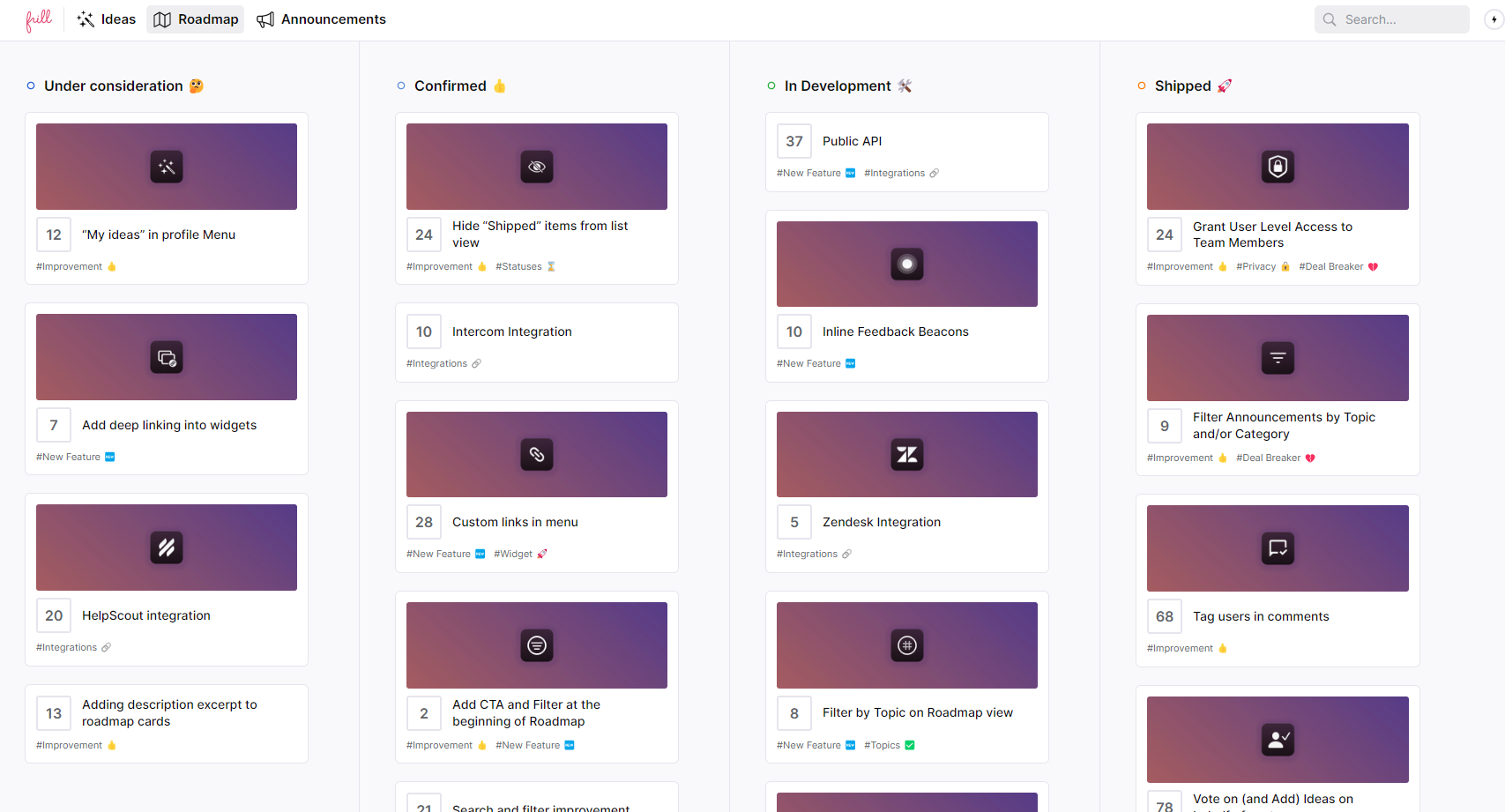
It's important to continuously update your idea board and label new customer ideas so that customers know that you value their ideas.
You should also comment on customer ideas and ask for additional questions. This helps you understand their idea better while also making it clear that you value their input.
Here are some feature request tools and customer idea survey tools that are great for tracking ideas and improvements:
1. Frill
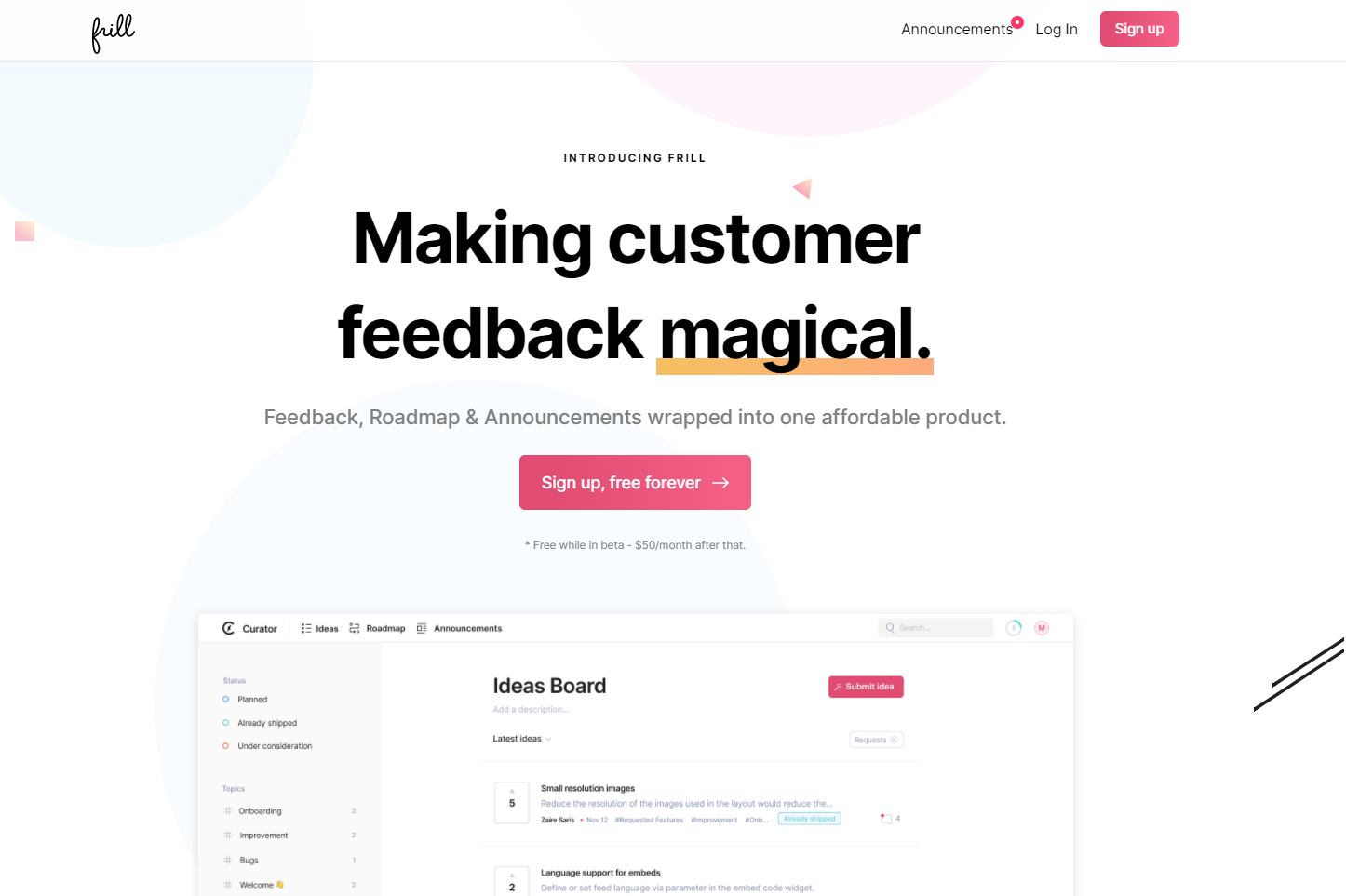
Frill is a customer feedback tool that includes idea boards, roadmaps, and release announcements in one place. It is a dedicated idea tracker because you can track ideas from your customers to approved to in production to complete. You can create whatever statuses you'd like for your board's columns.
2. SurveyMonkey
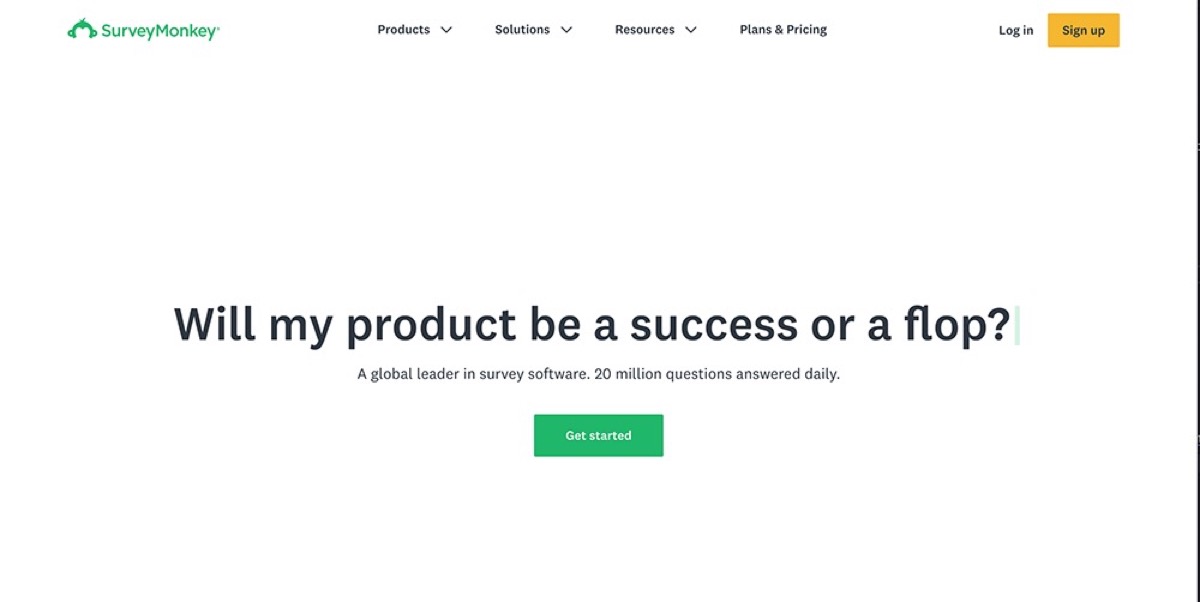
With SurveyMonkey, you can create idea forms and surveys for your customers to complete. You can then reuse these surveys monthly or annually so you can continue to track ideas in one place. If you utilize multiple choice questions, it will be easier to track the popularity of different ideas. But it's smart to use some open-ended questions as well, so that customers can submit ideas freely.
3. Typeform
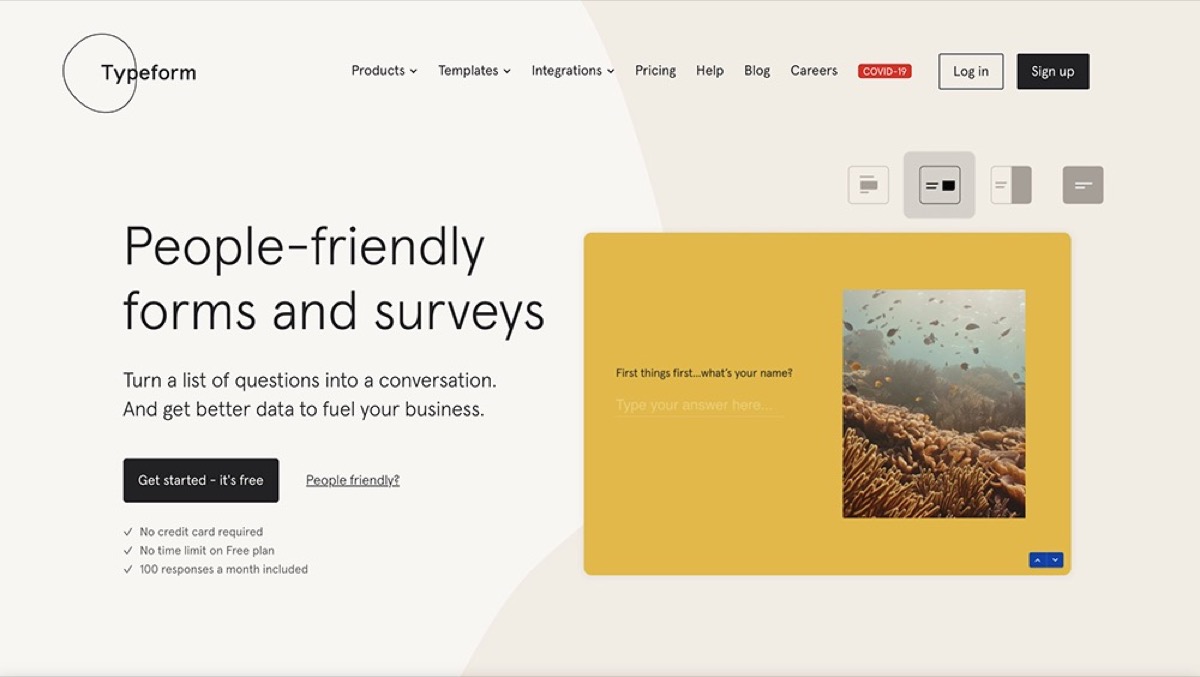
Typeform is similar to SurveyMonkey, except the UX is different. Customers will see just one question at a time, making the survey experience a little simpler and more straightforward. By re-using the same Typeform over and over, you'll be able to track customer ideas in one place.
Product feedback forms and survey tools can help you collect customer feedback in one place, but they don't make it easy to track the progress of an idea, so make sure to use something like Frill, which offers idea and roadmap boards. They're kanban-style, meaning you can track the progress of each idea in columns.
4. Canny
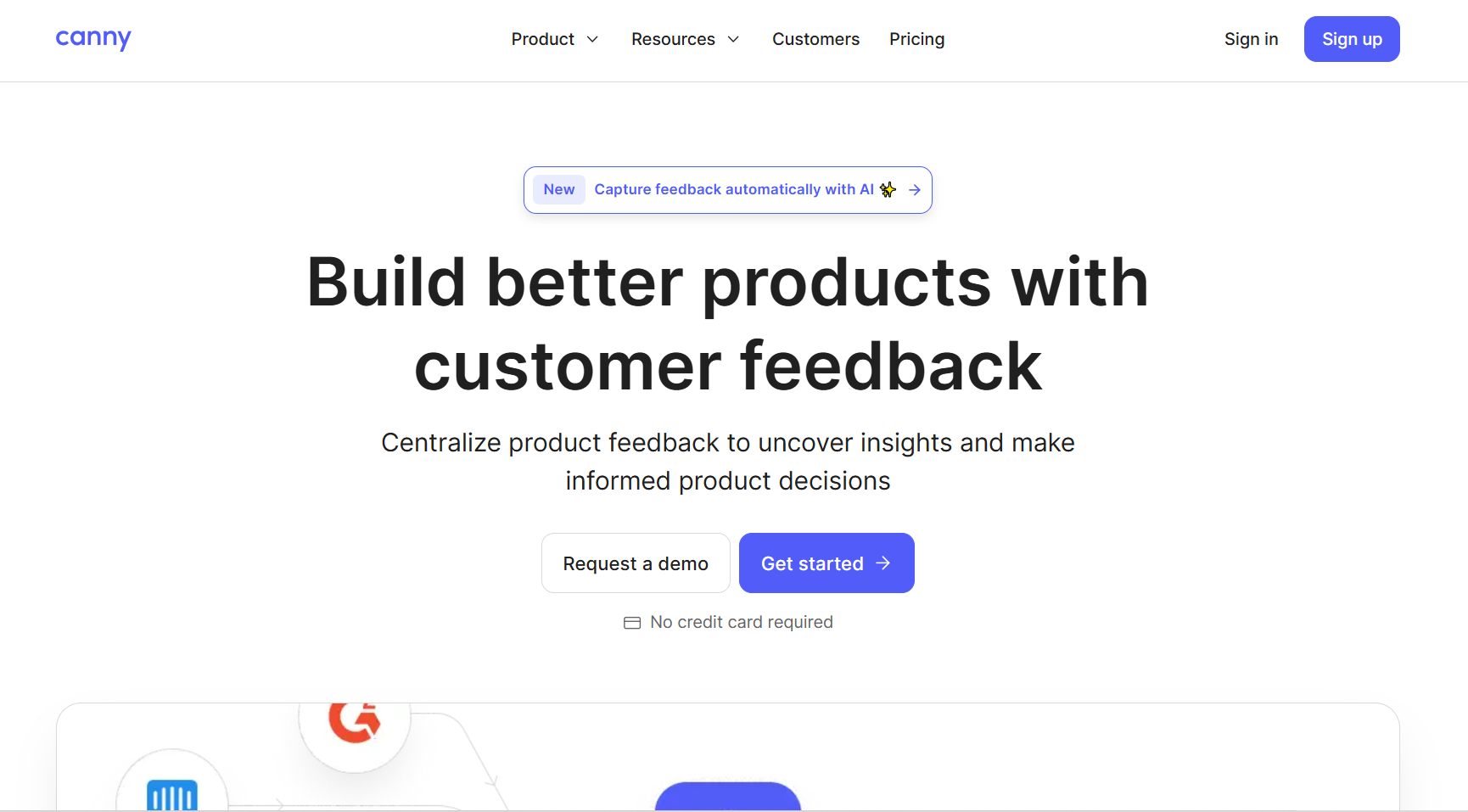
Canny helps SaaS companies collect, organize, and prioritize product feedback from users. Its clean UI makes it easy to track requests, while features like user voting, post merging, and feedback segmentation help product teams identify what matters most.
Canny also includes public or private roadmaps, changelogs, and a prioritization scoring system that connects directly with tools like Jira and GitHub. It’s well-suited for growing teams that want a user-driven workflow with minimal setup and strong internal visibility.
5. UserVoice

UserVoice is a robust feedback management platform designed for mid-sized to enterprise-level organizations. It supports large-scale idea collection with features like advanced segmentation, CRM integration, and guided validation workflows. T
eams can centralize feedback from across departments and connect it to product strategy using real-time reporting and customizable dashboards. With tools for outreach campaigns, internal collaboration, and customer follow-ups, UserVoice goes beyond idea tracking to support full-cycle product research and innovation at scale.
5 best idea tracking tools for business and marketing projects
When it comes to managing ideas for your business or job, you need a different type of platform.
Small businesses don't need a dedicated idea management tracker (see the next section below), but instead can get by with a project management tool.
All you need to do is create a separate column in your Kanban board and call it "ideas." Put any new ideas in there and chat with your team before deciding to build them.
You could also create a separate project board for ideas and add different columns for your idea tracking process.
Here are some columns you could use:
New
In Consideration
Approved
Planned
After you move an idea to the "Planned" column, you would then add it to the backlog of whatever project board it should go to, such as a content marketing board or an operational improvements project board.
All of these tools can be used by small businesses and enterpreneurs for tracking ideas.
1. ClickUp
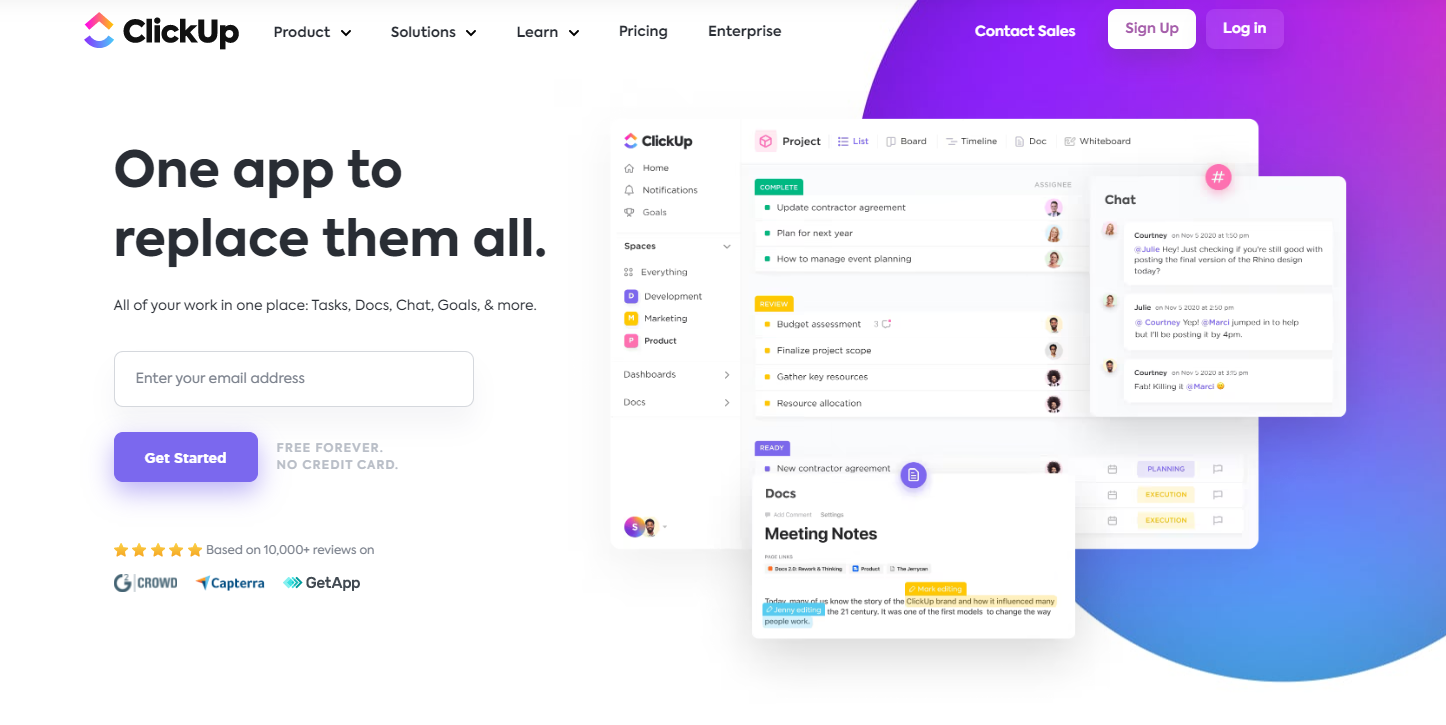
ClickUp is a great tool because you can toggle between different views for the same data. This means you can take a look at your ideas in a list view, calendar view, board view, and more. By having your ideas inside of ClickUp, you can easily move them over into action mode when you're ready.
2. Notion

Notion is great for tracking ideas, projects, internal information, wikis, etc. For example, you could make a doc with ideas for a certain project, and then turn each idea into its own project or task when the time is right.
3. Asana

Asana offers similar features to ClickUp and is a popular project management tool that can easily be used to track ideas. Make a separate board for idea tracking, or just add an "idea" column to each of your project boards so no idea slips through your fingers.
4. Milanote

This platform provides a very different approach. Milanote is a visual workspace designed for creative teams who want to organize their thinking in a more intuitive way. It's especially useful for marketers, designers, and writers who prefer working with flexible boards instead of rigid tables or lists.
You can drop in notes, images, to-dos, links, and files—all arranged in whatever layout makes the most sense for your project. Teams use it for campaign planning, mood boards, brand strategy, and more. It's like a digital whiteboard built for structured creativity.
5. Monday.com
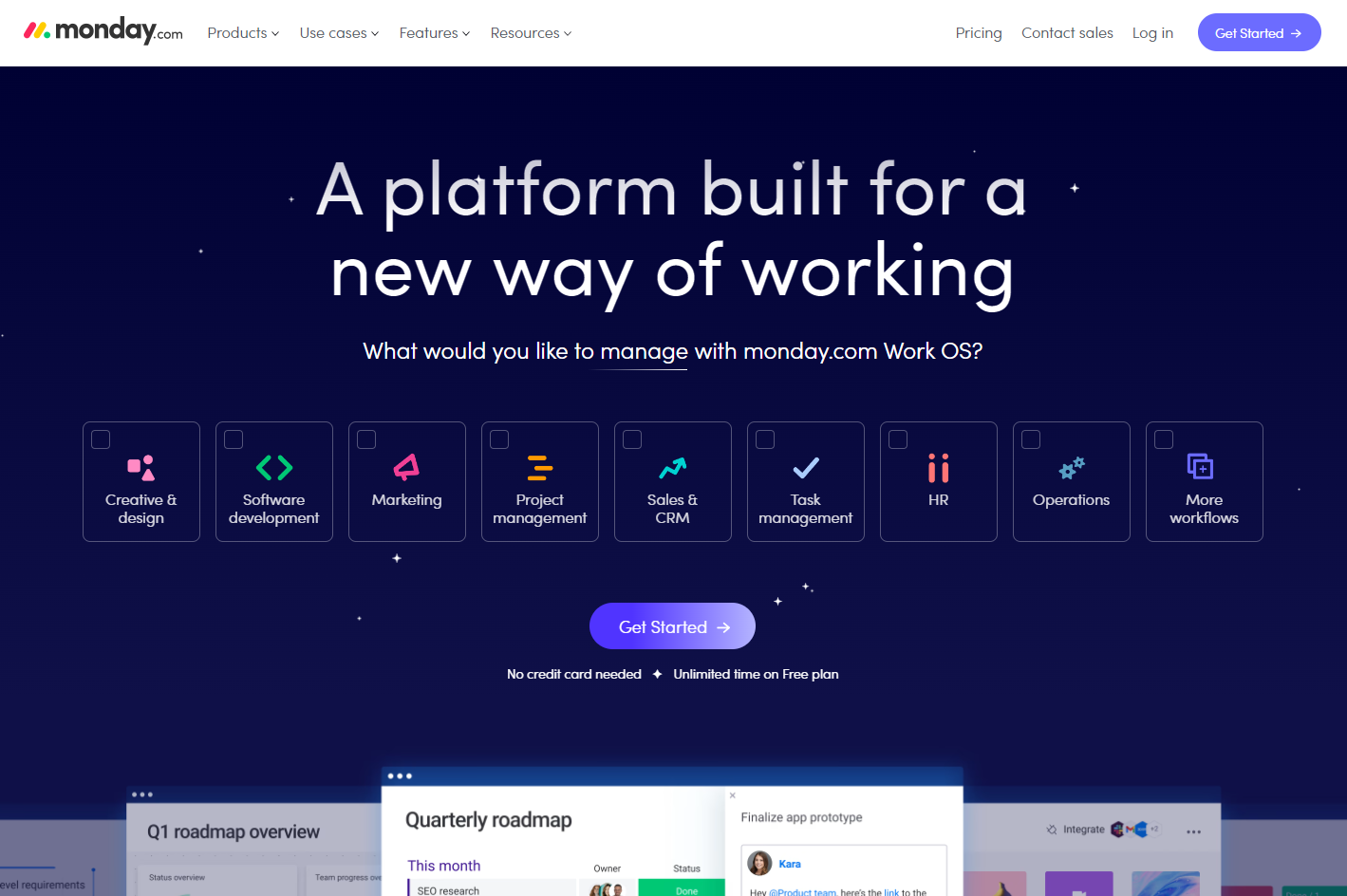
With Monday.com, you get a flexible operating system that helps teams manage projects, workflows, and ideas in one place. For small businesses and marketing teams, it offers a visual Kanban view and powerful automations to move ideas forward faster. You can create dedicated boards for brainstorming, set up idea evaluation columns, and easily connect ideas to project execution.
And with multiple views and built-in collaboration tools Monday.com scales with your team as your idea pipeline grows.
5 best idea tracking tools for enterprise companies
Enterprises have a much harder time of collecting and keeping track of ideas, so they need to use dedicated processes and tools, instead of their project management software.
Whitecollar workers at enterprise organizations can be kept very separate from the customer service and hands-on work that frontline employees do. That's why enterprises need to source ideas directly from frontline employees. They might have ideas on products, brick-and-mortar store organization, customer service improvements, and tons more.
These tools fall more into the idea management software category, because they're aimed at helping very large organizations to source ideas from employees across every department and function, even their on-the-ground, frontline staff.
1. Brightidea

With Brightidea, organizations can manage employee ideas in the Idea Box product, where you can collect, sort, and track ideas. There are also separate products for digital whiteboard brainstorms, managing incentivization programs, and tracking experiments and new innovation.
2. HelloIgnite
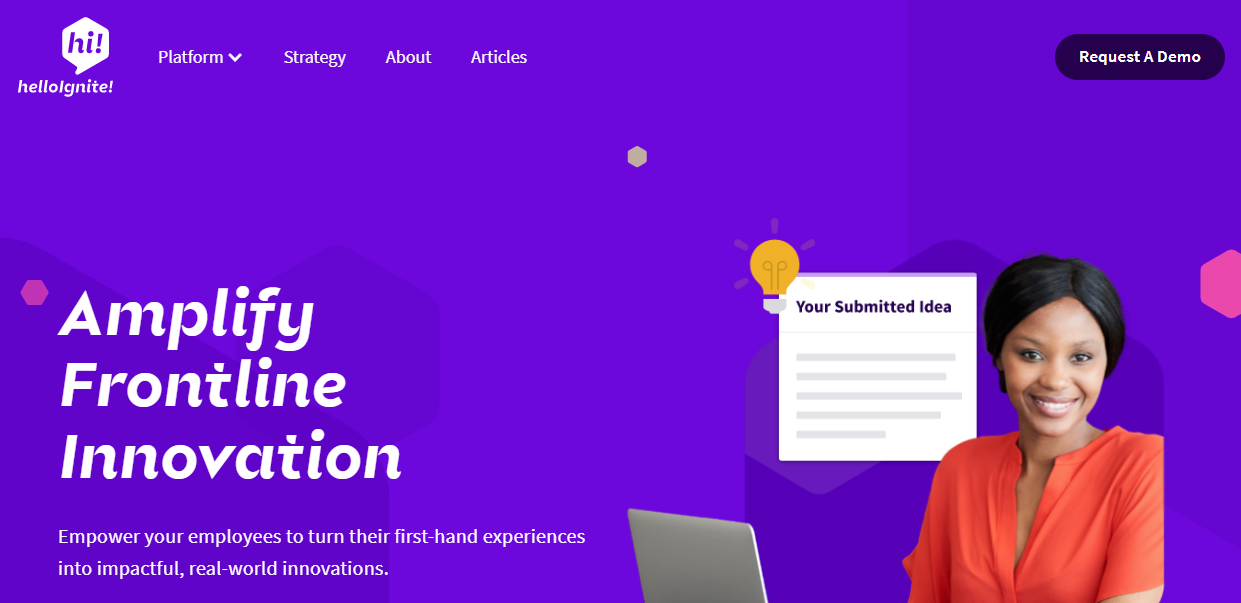
HelloIgnite is an idea-crowdsourcing platform. The platform is designed for organizations with a lot of frontline employees, all of whom hold immensely powerful information on what customers really want.
It makes it easy to collect ideas from team members across locations, roles, and shifts—ensuring no valuable insights are lost. HelloIgnite also supports collaborative voting and discussion, so the best ideas rise to the top through team input. The platform is especially useful for companies in retail, healthcare, and manufacturing where customer-facing staff often identify gaps long before leadership does.
3. Planbox

Planbox is an innovation management solution with features for idea tracking, tech scouting, new corporate ventures, employee engagement, and continuous improvement management. It supports both incremental improvements and disruptive innovation by helping teams explore, validate, and scale new concepts.
Planbox also integrates with popular business tools, making it easier to turn approved ideas into strategic projects. With robust reporting and workflow automation, large organizations can manage thousands of ideas while maintaining structure and speed. Planbox is often used by companies looking to formalize and scale their innovation programs without adding operational overhead. .
4. IdeaScale
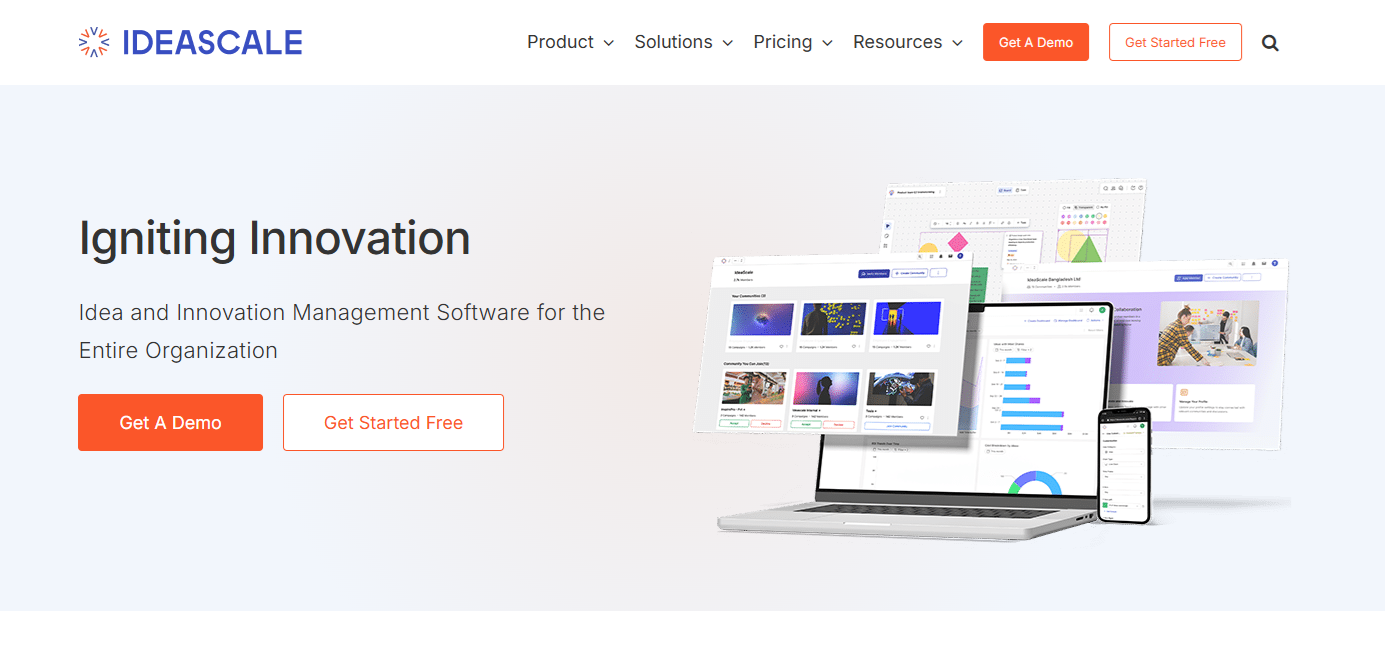
IdeaScale is built to help large organizations collect and develop ideas from across the company. It supports structured idea collection at scale, whether you are gathering input from frontline staff or senior leadership.
Ideas can be submitted, discussed, voted on, and developed into full proposals—all within one platform. The built-in whiteboard allows for visual brainstorming and collaborative refinement. Teams can track each idea from submission to execution. Powerful analytics highlight trends and surface the highest-potential opportunities. IdeaScale also supports dedicated campaigns, helping you focus on specific business challenges.
5. Qmarkets

Qmarkets is an end-to-end innovation platform for large enterprises that want to turn ideas into business results. Its tools help teams gather ideas aligned with strategic goals, validate them through AI-powered scoring, and turn them into action.
With Q-ideate, teams can manage the entire lifecycle of an idea—from challenge definition to execution and performance tracking. The platform is modular, meaning it can flex to fit different departments, business units, or use cases.
Enterprise teams use it to run global innovation campaigns, streamline decision-making, and demonstrate clear ROI on innovation efforts. Built-in analytics surface key metrics and insights, so leadership can prioritize the most impactful ideas.
How to validate and prioritize ideas
Here are some smart ways to prioritize feature requests and ideas from your customers:
1. Let customers upvote each others' ideas
Feature voting is a smart way to prioritize ideas. The idea with the most votes is the most popular and should be built as soon as possible.
To let your customers vote on ideas, you need to use a customer feedback tool that includes upvoting.
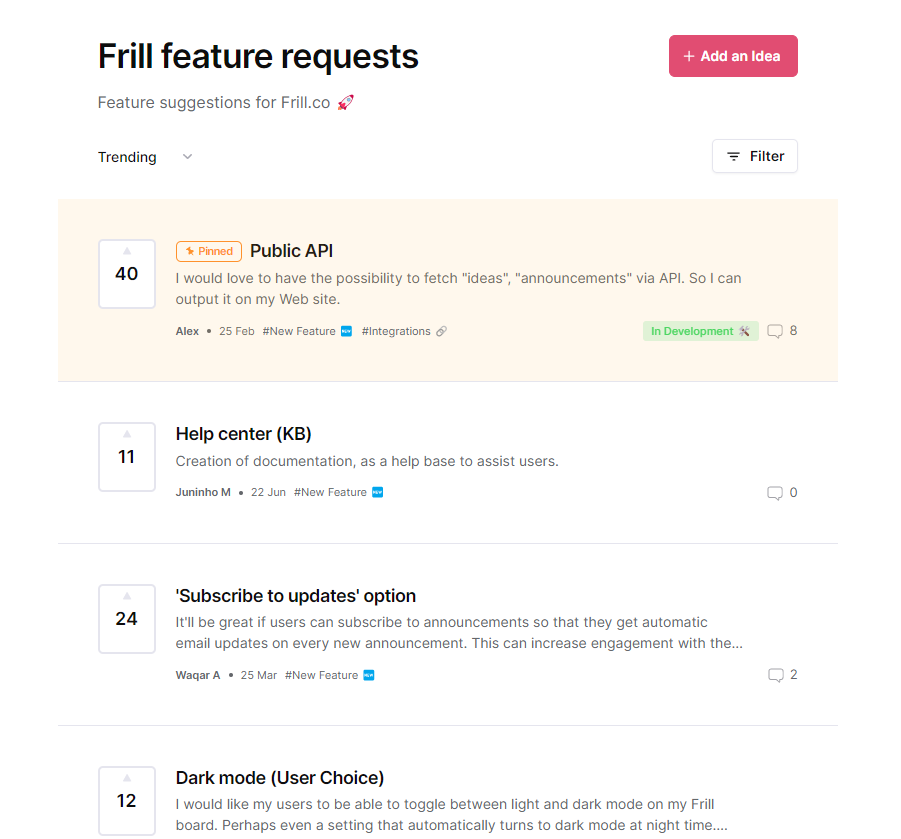
To increase the engagement with your feedback tool, use single sign-on (SSO) so your users can login with the same credential they use for your app or website. If you want, you can even allow users to upvote with being signed in.
2. Do what you can to reduce customer churn
You should always prioritize ideas that have the potential to reduce customer churn.
If it's clear that some of your best customers will leave unless you implement an idea, then you should put that at the top of your list.
“We often look at the prospect sources that give us the most conversion and prioritize the requests coming from this source. But our most recent feature updates were aimed at reducing customer churn. We therefore prioritized the feature requests from churned customers. Earlier segmentation of customers definitely helps when it comes to this.”
– Alina Clark, Co-Founder and Marketing Director of CocoDoc
3. Consider the competitive landscape
Do your competitors already satisfy this idea?
If you've fallen behind your competitors, you might need to prioritize customer ideas that will help you play catch up.
But before you go copying them, ask yourself: do you want to be like these competitors?
Just because competitors offer something, it doesn't necessarily mean that you should. Sometimes your competitors aren't very innovative or worth copying. Or they might serve a slightly different target audience.
So take this advance with a grain of salt.
4. Make sure the idea is aligned with your ICP
Sometimes a request is surprising but for the most part, we have a good idea of what our customers want from us. We usually prioritize requests based on what will have the biggest impact on our clients. That could come from the number of requests we’ll receive for a specific idea, or it could be something major that we need to fix ASAP.”
– Lindsey Allard, CEO & Co-Founder of PlaybookUX
5. Prioritize customer requests already in your roadmap
It's smart to prioritize customer ideas that you were already planning on building, or that align with your current product development well (and can be easily tacked on).
Essentially, if something is already in your roadmap is very highly requested, you should bump it to the very top of your priority list, as long as another idea isn't mission-critical.
How to track idea completion and share your successes
When you finish the task or project associate with an idea, make sure to track that too!
Here are some things you might do:
Move that idea over to your "complete" or "launched" column in your roadmap.
Comment on the original idea, let that person know its complete, and thank them for their idea. Also tag any customers who also commented with their thoughts on the original idea so they know its launched too.
Write a release note and publish it in your changelog so all of your customers know about the update (and see that you are a customer-centric organization).
Letting ideas fall through the cracks is a major waste. Follow these tips all you'll be able to not only track ideas but actually use them.
Frequently Asked Questions
How is idea tracking different from general project management?
Idea tracking focuses on collecting, evaluating, and prioritizing raw ideas before they become active projects. It gives early-stage concepts a place to live and evolve. Project management, on the other hand, starts once an idea is approved. Together, they create a seamless pipeline from inspiration to execution without letting insights go to waste.
Why should I use software to track ideas?
Without a centralized tool, ideas end up scattered across Slack threads, email chains, and notepads. Software keeps everything in one place, gives your team visibility into what’s been suggested, and adds structure with statuses, tags, and deadlines. This makes it easier to prioritize and take action on the ideas that matter most.
Who should be responsible for managing idea tracking?
Product managers typically own idea tracking, but cross-functional input is key. Customer support, marketing, sales, and ops often have valuable insights from daily user interactions. The best approach is shared ownership. Let PMs guide strategy while encouraging the whole team to contribute, organize, and refine ideas before they move into development.
Want to make your users happy? Track customer feedback and feature requests with Frill.